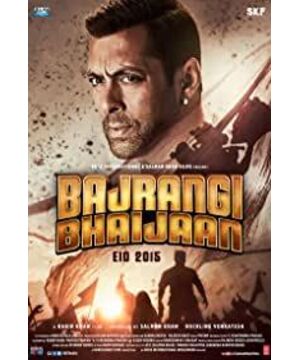Text | Tang Brigade published in MOViE Io
"Because I believe in the god Hanuman."
The male protagonist Pawan in the film has always talked about Mahabharata and Hanuman. God Hanuman originated from the Indian epic "Morayana". In mythology, he helped Prince Rama to find his wife and successfully rescued the princess Sita. This allusion is well-known in a country of original religion, and the screenwriter/director Kamil Khan also used this prototype religious figure to shape Pawan's image of sticking to his beliefs and maintaining love.
The model of the story is an uncle who met a lost little girl, temporarily took her in under the helpless and distressed situation, and sent her back home after all kinds of setbacks. There are naturally wandering roads and adventure elements in the film. This plot is easily reminiscent of Wim Wenders' series, such as "Alice in the City". The combination of uncle and loli, the presentation of wandering and road. Even the dignified Angelopoulos has films with similar plots, such as Eternity and a Day. Even though the styles of the three types of films are completely different, their content is related to the relationship between characters such as adults/children. Such a kind of youthful emotion that is not related to the relationship, not only contains the sense of responsibility of adults, but also comes from the spontaneous emotion of human beings.
Universal emotional motifs can never be judged by their obsolescence. The content still needs to be expressed in form, and then comprehensively considered. In terms of content, the relationship between Pawan and Shahida (even Pawan and his girlfriend, his girlfriend and his father, and Shahida and his mother) is enough to move people, but what makes the film pale is undoubtedly the inferior form. The artificial slow motion, unnecessary sensational music, vigorous performances, outdated MV-style editing techniques, etc., undoubtedly make the form unconventional. Natural emotions cannot be presented by these pretense. (The author also thinks of "Wuwen Xidong" and "Youth") Their content is actually relatively full, but the form chosen by the director is as gorgeous and unreal as a Korean drama that earns tears. Just like Korean movies and Hollywood movies, audiences have become accustomed to the set of emotional experience models they have created. Therefore, even if it is only for attendance, it is more secure for director Camille Han to choose this sensational form.
Although the form is so poor, it does not hide the fullness of the content. Power and prison, racial conflicts, emotions, twists and turns, enrich the content of the entire film. In addition, one of the advantages of Indian films is that, apart from the textual level, it still embodies many contents that are novel to people in other regions in an audio-visual way . This is also the difference between it and the Korean commercial films that focus on the plot, and the Hollywood commercial films that have become aesthetically fixed.
The film is interspersed with a lot of music, some of which are soundtrack production, and the other part is more modern commercial style vocal songs. In the soundtrack production part, the national tambourine, national strings, harmonica and slightly undulating Indian vocals are combined to form World Music with Indian characteristics. Here, the vocals have some instrumental features, and the lyrics are Part of the text has an ideographic role, but the characteristic exotic vocals also share the effect of the auditory experience. World music goes side by side with modern commercial songs and has been used in various films.
When the mother brought Shahida to the temple in India to pray, folk music ran through the sacrifice process; at the end, when Pawan took Shahida to pray in the temple in Pakistan, the same music was also used in the sacrifice scene. vector. Song and dance and religion are inextricably linked, so the common song and dance elements of Indian films are very naturally integrated into religious ceremonies. When Pawan Monkey God first appeared, the modern pop song and dance performed were completely different. Powerful electronic music and funny movements are like the Indian version of "Gangnam Style". Subsequently, many sensational music about the characters is similar, what we usually call mass pop music.
Here we can see that the film presents the unique culture of our own region, as well as the culture under modern homogeneity, and also presents the ethnic conflict between India and Pakistan. After India's independence, the former British colony split into two countries, India and Pakistan. This split has led to frequent ethical conflicts between the two countries. Islam in Pakistan is at odds with Hinduism in India. This inter-ethnic chauvinism has also been deeply reflected in popular Indian films of the past, such as "My God". The film's advantage of restoring material reality is revealed. Based on this, we can intuitively feel the differences in architecture, clothing and other aspects between the two countries. Although the language is the same, the red-colored Indian buildings are distinct from the white-themed mosques, and the red and black veils on the hairline contradict each other.
And for the local people, shouldn't these cultural divides be an everyday occurrence? To examine an Indian film as a foreigner cannot escape the tinted glasses of post-colonialism. Obviously, the exotic religions, music, costumes, and architecture in the film all satisfy the imagination of people in other regions about the mysterious India. Exotic elements are otherized to accept prejudiced scrutiny from other regions. "When several German Orientalists learned to see a wonderful Indian statue for the first time in the early 19th century, their appreciation for the Orient was immediately replaced by possessiveness...creating another round of [being seen]. " (from the post-colonial chapter of Contemporary Western Literature and Art Theory) Even China, the subject of Orientalism, has gradually established itself as a part of the central subject, showing the curious pursuit of the culture of other nations by the literary class. So far, the subject is not only divided into regions, but a general phenomenon of class interest. Especially in China, which has no faith or culture.
This also happens to be the cultural strategy in the film. In the Pakistani region at the beginning, people in poor villages watched football around an old TV series, cheering and tears welling up in their eyes. But there is no Abbas in India, and immediately, this scene can only become a normal narrative scene of a commercial film, and it also has a slight suspicion of strategy. After Shahida came to New Delhi, the film also followed Shahida's perspective and browsed the humanities and customs of India. These scenes are more fleshed out in classic Indian musicals, but the strategy lends strength to India's resistance to cultural postcolonialism.
Korean films seem to have gone their own way, but have lost their own subject culture; when Europe and the United States construct their own post-colonial subjectivity, they constantly inject novel and exotic elements and pretend to be politically correct. The recent hit "Black Panther" is said to be a very apt example. On the contrary, what can really approach the coexistence of pluralism are those commercial films with richer content in foreign regions. Commercial films mean breaking into the public eye, into popular discourse. When the "novelized" exotic culture is presented many times, it becomes a constructed popular aesthetic method. And only when it is popular can it coexist and compete on an equal footing with other cultures. But this is still a very awkward situation, constantly changing itself in the construction process, incorporating foreign elements, and adapting to the existing popular aesthetics (such as the sensational form of this film).
Movies have been tightly choked by the West since their birth. Facts have proved that the new wave of the world (except Japanese movies) has not changed the dominant monopoly of Western movies. Those South American art films, Southeast Asian art films, etc. are still insignificant in the film pop industry. On the contrary, Bollywood's variety is appreciated by the public, which also means exporting its own culture to the public and explaining its own situation. This is a viable cultural strategy.
View more about Bajrangi Bhaijaan reviews











